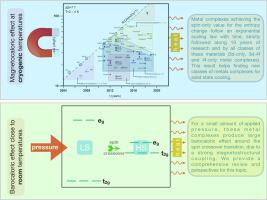Coordination Chemistry Reviews ( IF 20.3 ) Pub Date : 2020-05-07 , DOI: 10.1016/j.ccr.2020.213357 Mario S. Reis

|
Solid state refrigeration is a viable alternative for the conventional gas-compression technology due to the environmental friendliness of its materials, energy efficiency, and low noise. Research in this field is focused on the development of advanced prototypes and smart materials. This Review focuses on a special family of quantum materials: metal complexes. We introduce the fundamentals of caloric effects and magnetism of these complexes, discussing their applications at different ranges of temperature, based on different physical mechanisms. At cryogenic temperatures (close to temperature of liquid He), some metal complexes present a huge value of magnetic entropy change, ranging from c.a. 10 J/kgK to c.a. 70 J/kgK (for 7 T of magnetic field change). These values make some metal complexes appealing as cryogenic coolant materials. We also present a comprehensive collection of results from the literature, organized on a chart as a function of time, for different classes of metal complexes; those with 3d-3d magnetic interactions, 3d-4f coupling, and 4f-4f interactions. We observed that those materials that achieved the maximum value of entropy change, i.e., the spin-only value, follow an exponential scaling law with time. This result helps to predict a new class of metal complexes and further outcomes for the field. On the other hand, for a small amount of applied pressure, these materials produce large barocaloric effect around the spin crossover transition (this transition occurs in a wide range of temperature, even close to room temperature). Thus, we introduce the SCO mechanism and comprehensively review this topic, along with the recent theoretical models and experimental results. The recent results of barocaloric effect are considered enormously significant (56 J/kgK for 0.9 kbar of pressure change, close to room temperature), even in comparison with traditional metallic barocaloric materials. We also provide perspectives for this subject, with discussions about new mechanisms for the models (as the Jahn-Teller distortion and orbital contribution).
中文翻译:

金属配合物对固态冷却的磁热和压热效应:回顾,趋势和观点
固态制冷由于其材料的环境友好性,能源效率和低噪音而成为常规气体压缩技术的可行替代方案。该领域的研究集中于高级原型和智能材料的开发。这篇评论专注于特殊的量子材料家族:金属络合物。我们介绍了这些配合物的热效应和磁性的基本原理,并基于不同的物理机理讨论了它们在不同温度范围内的应用。在低温(接近液态He的温度)下,一些金属络合物的磁熵变值很大,范围从大约10 J / kgK到大约70 J / kgK(对于7 T的磁场变化)。这些值使得某些金属络合物成为低温冷却剂材料具有吸引力。我们还提供了针对不同类别的金属配合物的文献结果的综合收集,这些图表按时间组织在图表上。具有3d-3d磁性相互作用,3d-4f耦合和4f-4f相互作用的分子。我们观察到那些达到熵变化最大值(即自旋值)的材料遵循随时间变化的指数缩放定律。这一结果有助于预测一类新的金属络合物以及该领域的进一步成果。另一方面,对于少量施加的压力,这些材料在自旋交叉转变附近产生很大的压力效应(这种转变发生在很大的温度范围内,甚至接近室温)。因此,我们介绍了SCO机制并对该主题以及最近的理论模型和实验结果进行了全面回顾。即使与传统的金属压力材料相比,最近的压力效果也被认为是非常有意义的(压力变化为0.9 kbar,接近室温时为56 J / kgK)。











































 京公网安备 11010802027423号
京公网安备 11010802027423号